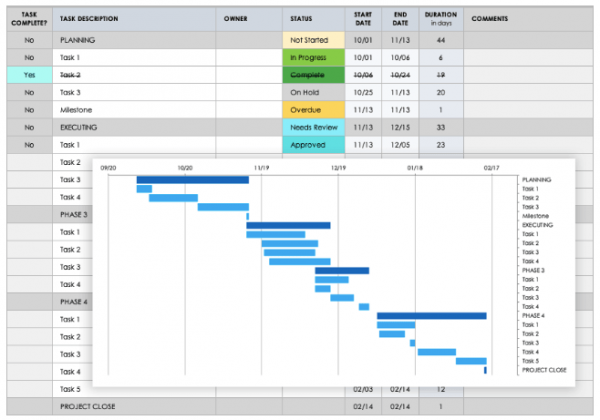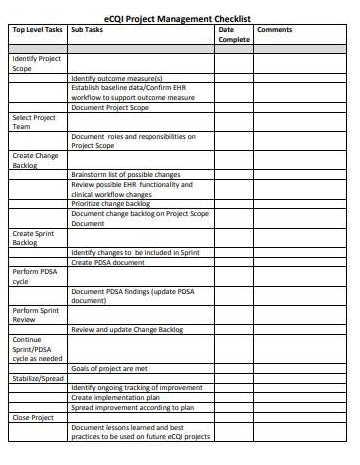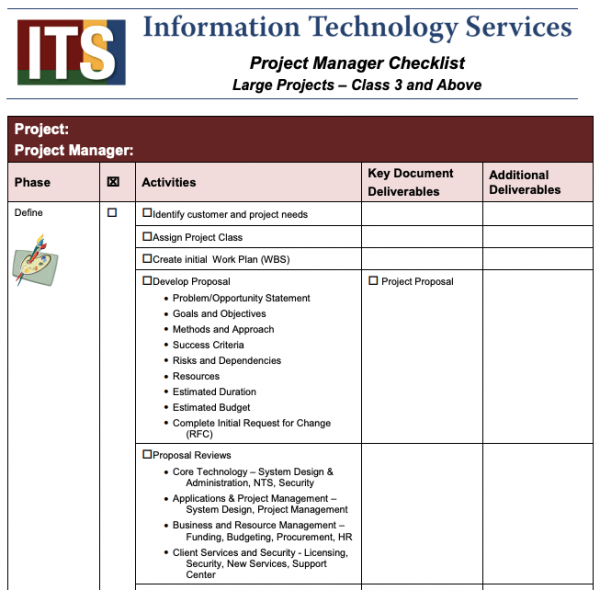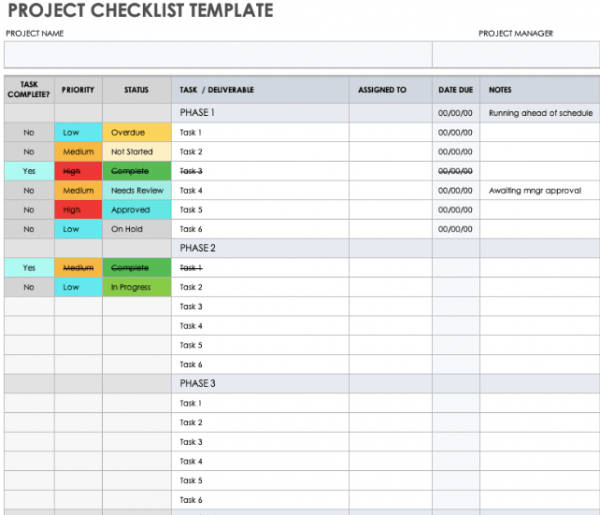As a project manager, you are responsible for ensuring that your team completes their work on time and within budget. One of the best ways to do this is to use a checklist. A checklist is a simple but powerful tool that can help you keep track of all the tasks that need to be completed during a project. A project manager checklist can also help you delegate tasks, track progress, and identify potential problems early on.
In project management, a checklist is a tool used to ensure that all necessary tasks have been completed. It is a list of items, usually with checkboxes beside them, that need to be ticked off as they are completed.
Checklists are often used in project planning to ensure that all necessary steps have been considered. They can also be used during the execution of a project to help keep track of progress and make sure that nothing has been forgotten.
While checklists are not a replacement for proper planning and execution, they can be a helpful tool to keep things on track.
Why Checklists are Important for the Project Managers?
As anyone who’s ever managed a project knows, it can be difficult to keep track of all the moving parts. That’s why a project manager checklist is an essential tool for any project manager.
Checklists are often seen as simple tools that can be used to achieve basic tasks. However, in the world of project management, checklists can be extremely beneficial.
When used correctly, checklists can help project managers save time, ensure accuracy, and improve communication. Checklists can also help to reduce stress levels and promote a sense of calm in hectic work environments.
It helps you make sure that nothing is forgotten and that all team members are aware of their responsibilities.
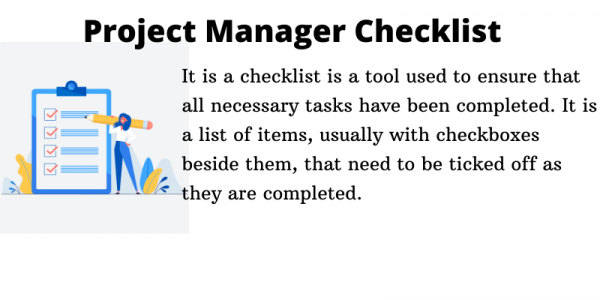
Tips when creating a Checklist
Creating a checklist can be tricky. You want to make sure that your checklist is comprehensive and user-friendly, or else it will just be another item on your to-do list.
To help you out, we’ve compiled a few tips on how to create a checklist for your next project.
1. Keep it simple. A checklist should be easy to understand and use. If it’s too complicated, your team will never use it.
2. Be specific. A good checklist should be specific to your project.
3. Make sure the checklist is accessible. Keep it in a place where it can be easily referenced and updated.
4. Use the checklist as a guide, not a law. Allow for flexibility and adaptation as the project progresses.
How to develop a Project Manager Checklist
The key to successful project management is organization and preparation. Before starting any project, it is essential to create a comprehensive checklist of all the tasks that need to be completed, the deadlines for each task, the resources required, and the goals that need to be achieved. To help you get started, we’ve compiled a list of the must-haves that you absolutely must include in your checklist. From setting milestones to creating a budget, this checklist will help you stay on track and prevent any potential problems.
Defining the scope of your project
Before you can start working on a project, you need to have a clear understanding of what the project entails. This means defining the goals and objectives of the project, as well as the specific tasks that need to be completed. Without a clear scope, it will be difficult to stay on track and complete the project successfully.
Creating a project timeline
Once you have a clear understanding of the scope of the project, you can start creating a timeline. This timeline should include all of the tasks that need to be completed, as well as the deadlines for each task. Having a timeline will help you stay on track and ensure that all tasks are completed on time.
Assigning tasks and assigning deadlines
Once you have a timeline, you need to start assigning tasks to specific team members. Make sure to assign each task a deadline so that everyone knows when it is due. Having clear deadlines will help to ensure that the project is completed on time.
Determining the project budget
Another important aspect of project management is creating a budget. You need to determine how much money you have available to spend on the project, as well as what resources are needed. Having a clear budget will help you stay on track and avoid overspending.
Managing changes to the project
During the course of a project, there will inevitably be some changes that need to be made. It is important to have a process in place for managing these changes so that they do not cause delays or problems.
Tracking project milestones
As the project progresses, it is important to track milestones and ensure that they are being met. This will help you gauge the progress of the project and make sure that it is on track.
Risk management
Every project comes with some degree of risk. It is important to identify potential risks early on and put a plan in place for how to deal with them if they occur. This will help to avoid any potential problems down the line.
Communicating with the project team
Throughout the course of the project, it is important to keep communication open with all members of the team. This includes regular updates on progress, as well as any changes that need to be made. Good communication will help to ensure that everyone is on the same page and avoid any misunderstandings.
Reporting progress
Stakeholders will typically want to see this list on a regular basis, so it’s important to keep it up to date. You can use project management software to do this, or you can simply update the list manually as tasks are completed. Either way, progress reports are an essential part of project management and should not
What should be included in a Project Manager checklist?
When creating the checklist, there are a few key things that should be included:
- Project goal: What is the overall goal of the project? What do you hope to achieve?
- Project scope: What tasks need to be completed in order to reach the goal? What is included in the project, and what is outside of the scope?
- Project timeline: When do you plan to start and finish the project? When are key milestones or deadlines?
- Project budget: How much will the project cost? Are there any funding limitations?
- Project risks: What could go wrong during the course of the project? What are the potential risks and consequences?
Examples of Project Manager Checklists
Here are a few different ways that you can use a project manager checklist:
- To create a task list: A project management checklist can be used as a task list, which can be helpful when delegating tasks to team members. Simply write out all of the tasks that need to be completed, then assign each task to a specific team member.
- To set deadlines: In addition to listing tasks, you can also use your checklist to set deadlines. This can help to ensure that tasks are completed on time, and avoid any delays in the project timeline.
- To track progress: As mentioned earlier, checking off items on your checklist can help you to track your progress and stay motivated as you work towards completing the project.
- To document the project: In addition to tracking your own progress, you can also use your checklist as documentation for the entire project. This can be helpful if you need to reference the project at a later date, or if you want to share it with others who were not involved in the project.
FAQs
What is the importance of the Project Manager Checklist?
They help you to stay organized and on track. It can be easy to lose sight of tasks and deadlines when you’re managing a complex project. This checklist can help to improve communication between you and your team. By having a clear and concise list of tasks, everyone on the team knows what needs to be done and when it needs to be done.
What is a project manager checklist?
A project manager checklist is a tool used by project managers to plan, organize, and track tasks, deadlines, and deliverables during a project.
What should be included in a project manager checklist?
When creating a project management checklist, there are a few key things that should be included: Project goal, Project scope, Project timeline, Project budget, and Project risks.
How can you use a project management checklist?
There are a few different ways that you can use a project management checklist:
To create a task list, set deadlines, track progress, and, don’t forget that is essential to document the project to be perfectly clear.

